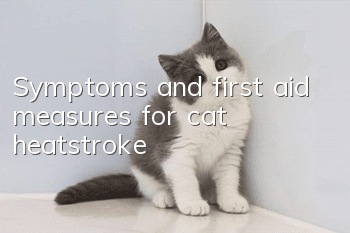Symptoms and first aid measures for cat heatstroke

Symptoms of heat stroke in cats
1. Under normal circumstances, a cat’s body temperature is between 37-39°C, but if there is heat stroke, its body temperature may reach 41~ 42℃.
2. He may even take a big breath and gasp for air. In severe cases, he will stick out his tongue and gasp like a dog.
3. You lie down all day and look listless. When you go to play with your cat, you will find that it is completely weak.
4. Cats with severe heat stroke will also show symptoms of dehydration, such as sunken eyeballs, red tongue, and foaming at the mouth. In more severe cases, convulsions and coma may occur.
First aid measures for cats suffering from heat stroke
1. Cats suffering from heat stroke are mostly caused by staying in hot places for too long. Therefore, when you notice signs of heat stroke in your cat, you should promptly move the cat to a cool and ventilated place to ensure that it does not cause more serious problems due to environmental reasons.
2. You can use a cool wet towel to wipe the cat's hair to reduce its surface temperature; or you can directly turn on the air conditioner to reduce the indoor temperature to achieve a cooling effect.
3. Because heat stroke will cause the cat's body temperature to rise, and the body's water content will gradually decrease, the cat should be guided to drink more water to maintain the body's water content and avoid dehydration symptoms.
4. If the cat has convulsions or coma, it is not recommended to treat it at home or continue to observe it. It should be sent to the hospital in time to avoid nervous system damage or death due to lack of timely treatment.
Preventive Measures for Cat Heatstroke
If you want to prevent cats from heatstroke, you only need to prevent cats from staying in hot places for long periods of time and keep them at home. Good ventilation. And when summer comes, cut the cat's fur short, which can help the cat dissipate heat. And in hot weather, cats should also be guided to drink more water to avoid excessive evaporation of water in the cat's body and symptoms of dehydration.
- A cat will die if it urinates for a few days
- Should you deworm yourself or go to a pet store?
- Are cat teasers harmful to cats?
- What should I do if my cat suffers from chronic gingivitis?
- Cat's nails are cracked with a thin layer
- Cats go crazy after eating mutton
- What does cat moss on a cat’s chin look like?
- Can cats reproduce after abdominal transmission is cured?
- What exactly is the sterilization shot for female cats?
- Can I still eat unopened cat food if it has expired?



